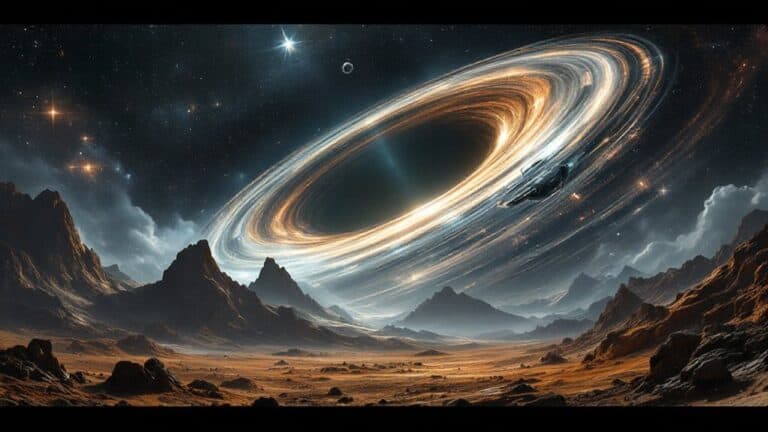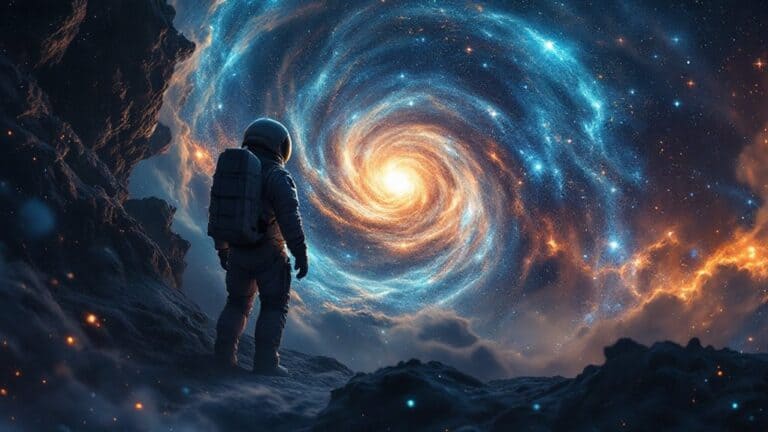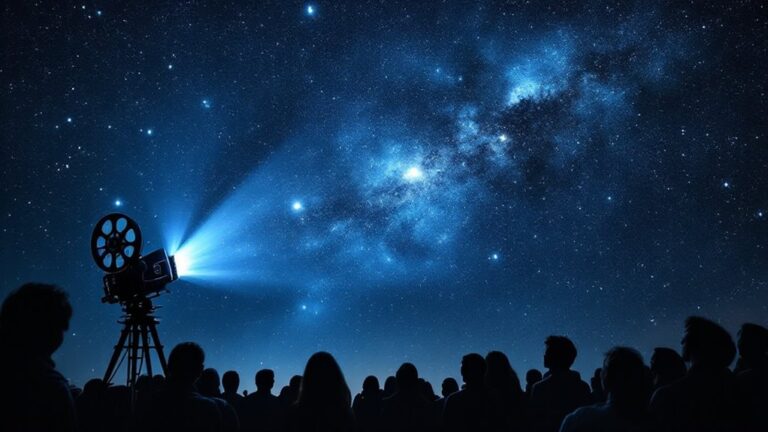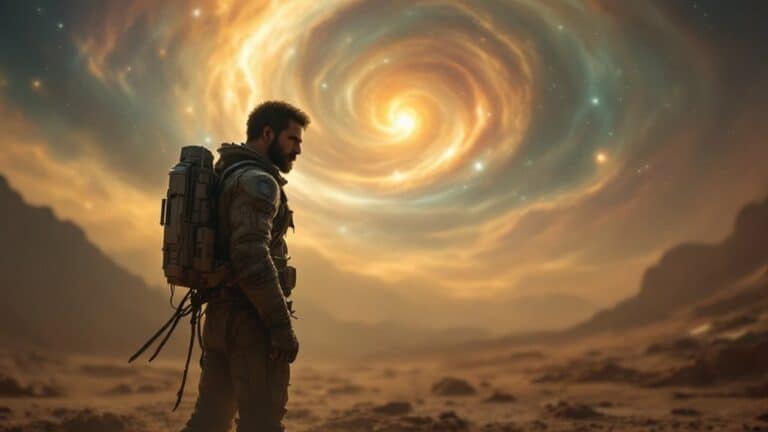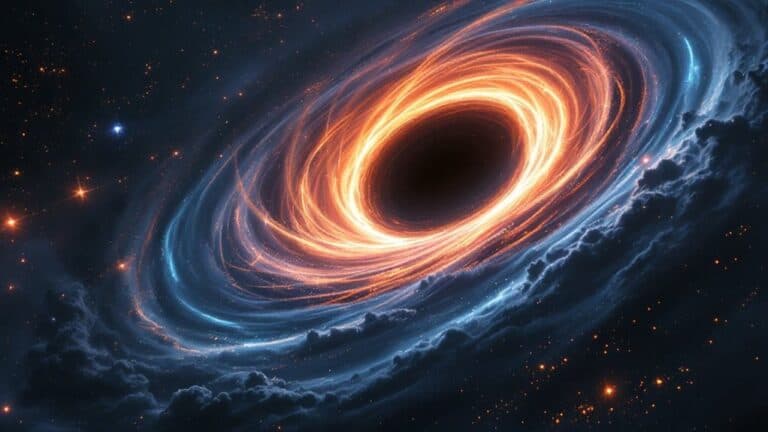How Christopher Nolan Uses Practical Effects to Ground Interstellar in Reality
Christopher Nolan effectively uses practical effects in *Interstellar* to root its ambitious story in reality, creating an emotional resonance that captivates viewers. By cultivating real cornfields and simulating massive ocean waves, he crafts environments that feel incredibly authentic. His collaboration with physicist Kip Thorne guarantees scientific concepts, like black holes, are vividly depicted, enhancing relatability. Innovative techniques, such as the Double Negative Gravitational Renderer, inject realism into fantastical imagery. These choices not only invite appreciation for artistic craftsmanship but also inspire awe, bridging imagination and truth. You’ll find even more fascinating insights into this film’s unique approach as you explore further.
Table of Contents
Key Takeaways
- Christopher Nolan employed full-size sets and practical effects to create immersive environments, enhancing the film’s realism and emotional impact.
- Real waves and natural landscapes were used instead of CGI, providing tangible authenticity to the visual narrative.
- Collaboration with scientific experts ensured accurate depictions of complex concepts, making the science in *Interstellar* relatable and grounded.
- Innovative techniques like the Double Negative Gravitational Renderer enhanced visual fidelity, bringing abstract scientific ideas to life through practical effects.
- The film’s practical effects fostered deeper audience engagement, bridging the gap between imagination and scientific truths.
Importance of Practical Effects
When it comes to filmmaking, practical effects stand out as a fundamental element that can elevate a movie’s impact. They offer a level of tangible realism that digital effects often struggle to achieve. Imagine actors engaging with real-world elements, which enhances their performances and makes their emotions feel authentic.
In action sequences, like explosions or stunts, practical effects create a visceral experience that immerses you deeper into the story, evoking genuine awe and even dread. These effects ground the film in reality, allowing fantastical moments to resonate with you on a personal level. The artistry behind practical effects shapes iconic cinematic scenes, ensuring their relevance in modern filmmaking. By utilizing full-size sets instead of relying solely on CGI, filmmakers can craft immersive experiences that feel more believable and emotionally engaging. Practical effects also showcase a unique textural quality that adds depth to the visual narrative, inviting you to appreciate the artistry involved in creating complex environments. Additionally, advancements in technology have revived traditional practical effects techniques, allowing filmmakers to enhance realism even further.
Moreover, the use of practical effects often sparks a sense of excitement among audiences, as you recognize the real effort and craftsmanship behind each scene. This connection not only enhances your viewing experience but fosters a shared appreciation for the creativity and innovation that underpin the magic of cinema.
The Corn Field Technique
The corn field technique in *Interstellar* exemplifies how practical effects can create a strikingly immersive experience. By cultivating 500 acres of corn in Alberta, Canada, the filmmakers crafted a stunning backdrop that not only grounds the story but also enhances the emotional connection to Cooper’s farm. This meticulous corn cultivation brought forth breathtaking cinematic landscapes that you can’t help but appreciate.
- The gamble of growing corn in an unsuitable climate showcased the team’s dedication.
- Extensive research and expert consultations guaranteed the project’s success.
- Real corn adds depth and authenticity, far surpassing the visual limitations of CGI.
- The project even turned a profit, demonstrating the corn’s lasting impact on the film.
- Nolan’s commitment to traditional filmmaking techniques emphasizes the value of using real elements on set, enhancing the overall visual storytelling. His focus on creative control allowed him to maintain a strong vision throughout the project.
With every detail controlled, these filmmakers elevated the art of storytelling, allowing you to feel the weight of the characters’ struggles in a beautifully rendered world.
The practical approach not only distinguished Christopher Nolan’s vision but also set a new standard for future films. In doing so, they reaffirmed the importance of tangible elements in cinema, reminding us that reality, even in its fictional forms, can resonate deeply within us.
Crafting Realistic Ocean Waves

Crafting realistic ocean waves in *Interstellar* required a blend of innovation and imagination, pushing the boundaries of what’s possible in film. To create these staggering, 4,000-foot waves, the team started with footage of massive waves off the coast of Hawaii, using it as a foundation. They didn’t stop there; they relied on their creativity to conceive waves that defy Earthly existence.
Employing a proprietary Squirt Ocean Toolset, they meticulously simulated wave behavior, ensuring every detail—from surface foam to spray—adhered to ocean physics. The challenge lay in balancing artistic expression with scientific accuracy. As they navigated the complexities of rendering waves interacting with spacecraft and actors, they remained committed to delivering a visually stunning experience. This dedication to realism was further enhanced by the film’s collaboration with astrophysicist Kip Thorne, ensuring adherence to scientific principles. Notably, the film’s exploration of time dilation exemplifies the intricate relationship between science and visual storytelling. In line with the philosophy of realism in filmmaking, the team understood that practical effects would significantly enhance the audience’s immersion.
No green screens were involved; instead, they integrated practical effects with their CGI to highlight realism. The result was a breathtaking portrayal that resonated with audiences, drawing them into the immersive world Nolan envisioned.
Through this meticulous approach to ocean waves, the film not only showcased technical expertise but also embraced a sense of wonder, reminding us of the beauty and power of nature, even in the vastness of space.
Collaboration for Authenticity
Collaborating with physicist Kip Thorne brought an unparalleled level of authenticity to *Interstellar*. By leveraging Thorne’s expertise in astrophysics, the film team guaranteed scientific accuracy while creating a visual representation that resonates deeply with audiences. Thorne’s research provided invaluable insights, allowing the filmmakers to visualize complex concepts that might otherwise be abstract.
- The collaboration resulted in the most scientifically accurate image of a black hole ever created.
- Thorne’s knowledge bridged the gap between art and science, enriching the narrative.
- The team used practical effects to enhance visual storytelling, making the science feel tangible.
- This partnership fostered a sense of belonging for viewers, connecting them to real scientific principles. Furthermore, this unique collaboration highlights the potential for future projects that blend science with cinematic storytelling. Notably, Nolan’s commitment to practical effects often leads to groundbreaking visual achievements.
Through this unique collaboration, Interstellar not only entertained but also educated, fostering a sense of wonder about the universe.
It’s inspiring to think about how art can elevate scientific concepts, transforming them into something relatable and engaging. By prioritizing authenticity, Nolan and his team didn’t just craft a film; they initiated a dialogue between science and storytelling, inviting everyone to explore the mysteries of space with them.
Groundbreaking Black Hole Effects
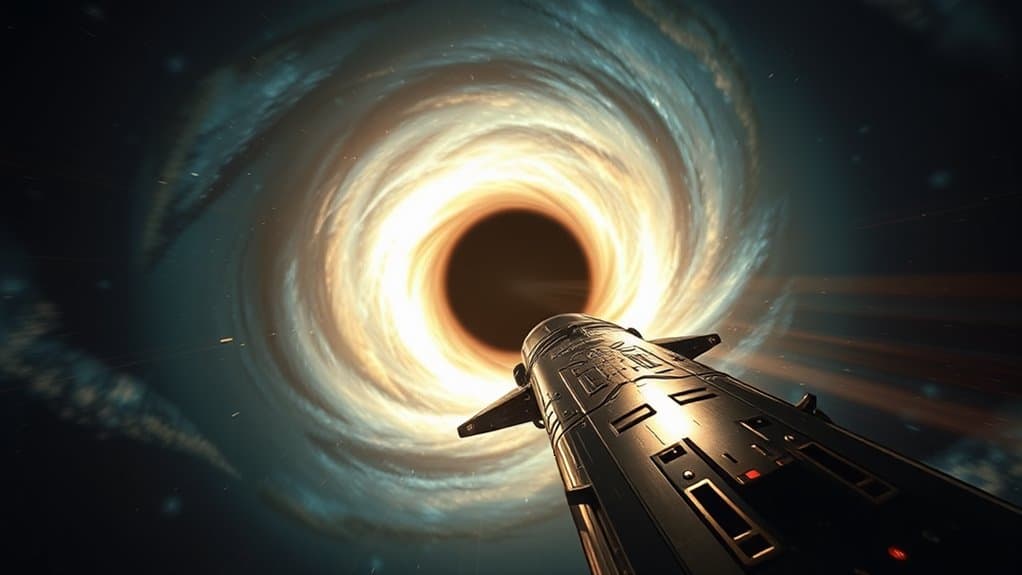
Building on the collaboration with Kip Thorne, *Interstellar* pushed the boundaries of visual effects to create groundbreaking representations of black holes. Through innovative black hole visualization techniques, the film depicted a scientifically accurate portrayal that captivated audiences.
Using the Double Negative Gravitational Renderer (DNGR), the team mapped millions of light beams as they navigated through warped spacetime, creating a stunning visual narrative. The caustics effects, highlighting multiple images of stars, further enriched the cinematic experience, pulling viewers into the black hole’s gravitational embrace. Gravitational lensing distorted light from the surrounding accretion disk, producing iconic visuals that felt both otherworldly and grounded in reality. Furthermore, this technique aims to eliminate flickering in black hole imagery, enhancing our understanding of cosmic phenomena.
What’s truly remarkable is that real-world scientists later confirmed the accuracy of these visual effects, including the asymmetrical rotational model of the black hole. This intersection of art and science not only entertained but also educated, inspiring new scientific discussions and papers. Additionally, the research on gravitational lensing has deepened our understanding of how light behaves around massive objects in space. The film’s groundbreaking visual effects even contributed to the development of CGI techniques that are now utilized in scientific research.
You can’t help but feel a sense of belonging to a community that values both creativity and discovery. In *Interstellar*, black holes aren’t just cosmic phenomena; they become a bridge between imagination and the scientific truths that shape our universe.
Merging Science With Art
*Interstellar* masterfully merges science with art, creating a cinematic experience that feels both imaginative and grounded. By collaborating closely with physicist Kip Thorne, the film guarantees that its scientific visualization resonates with authenticity, particularly in its portrayal of the black hole Gargantua.
This effort exemplifies how artistic interpretation can elevate scientific concepts into visual narratives that captivate and educate.
- The tesseract sequence visualizes four-dimensional space, allowing viewers to grasp complex ideas.
- Realistic environments, crafted through practical effects, enhance the actors’ performances and deepen audience immersion.
- Detailed simulations mimic extreme phenomena, like 4,000-foot waves, blending real footage with digital effects.
- Full-scale sets and hydraulic systems create dynamic interactions, making abstract concepts tangible. The film’s depiction of black hole Gargantua was meticulously designed for scientific accuracy, ensuring that visual effects align with real astrophysical principles. Additionally, the use of practical effects over CGI lends a sense of weight and realism to the interstellar journeys, making them feel more visceral and believable.
Inspiring Awe Through Realism

Through breathtaking visuals and meticulous attention to detail, *Interstellar* inspires awe by grounding its otherworldly environments in realism. You experience this film as more than just a story; it’s a journey through meticulously crafted landscapes that feel tangible and alive.
Filming in stunning locations like Iceland and Alberta, the team captured the raw beauty of nature, enhancing the film’s authenticity. The use of practical effects, like real waves and weathered cornfields, invites you to connect with the characters’ struggles on a profound level.
Nolan’s choice to employ IMAX cameras and high-quality lenses elevates the visual storytelling, allowing you to immerse yourself in the expansive beauty of space while still feeling the weight of human emotion. Each frame is a demonstration of the collaborative effort that prioritizes realism over CGI, creating a genuine immersive experience.
Conclusion
In “Interstellar,” Christopher Nolan transforms the cosmos into a tangible experience, grounding the extraordinary in the familiar. By weaving practical effects throughout the film, he invites you to feel the weight of space travel, much like how gravity tugs at your very being. This meticulous attention to realism not only captivates your senses but also ignites a profound appreciation for the science behind the spectacle. Ultimately, Nolan crafts a journey that echoes the timeless quest for understanding our universe.


